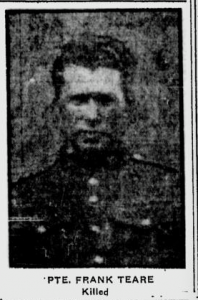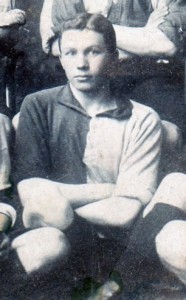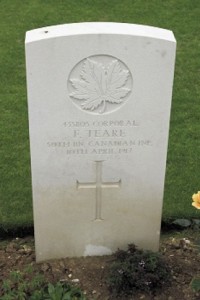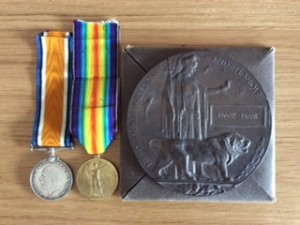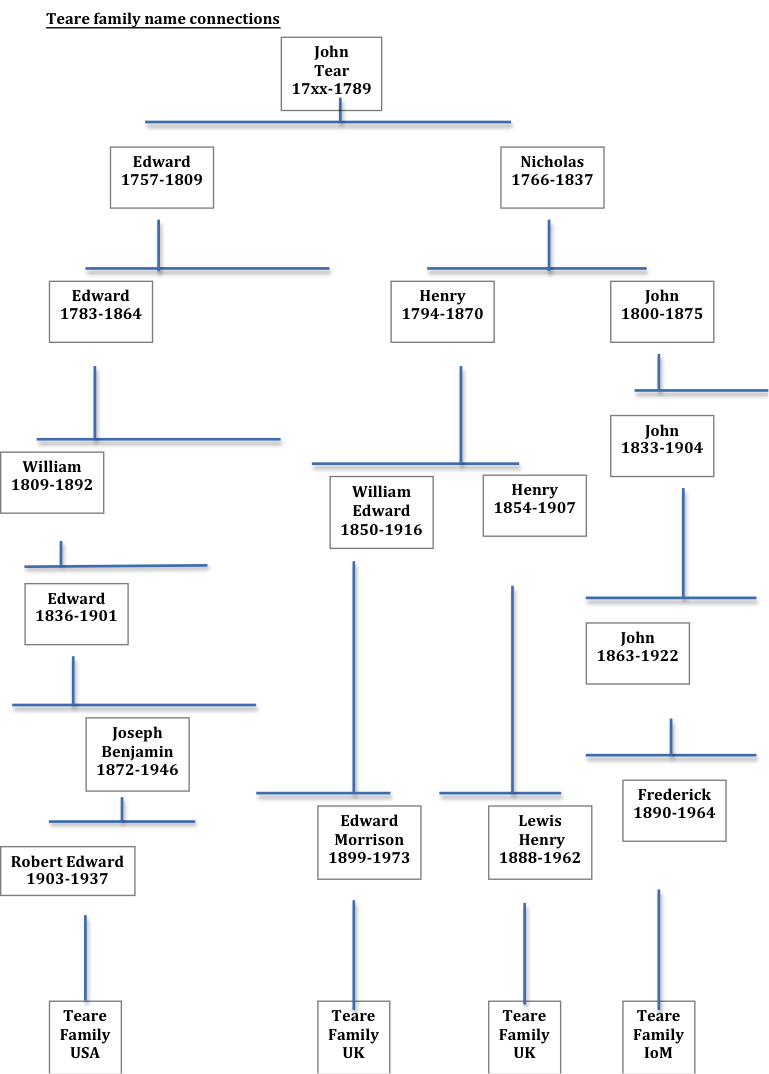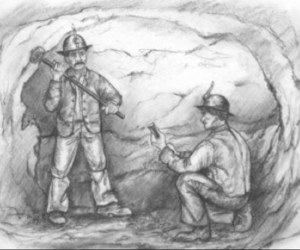
Mining has a long history on the Isle of Man with earliest records going back to 1246 when King Harald granted mining rights to the monks of Furness Abbey. During the period from the 1830’s there was a great revival in the Manx mining industry and rapid development. In1848 the Foxdale mines had proved to be the most productive in the island. In 1871 a new lease was granted and the mine was renamed the Central Foxdale Mine, sometimes know as the east mine. The three main shafts were renamed ‘Amy’, ‘Elizabeth’ and ‘Taylors’. Elizabeth was the deepest at 145 fathoms and was the engine shaft. The mine had a workforce 70 men underground and 45 at the surface in 1882 and the annual production of ore was between three and four hundred tons. (http://www.manxmines.com/FOXDALE%20MINE.htm )
John Teare jr. from West Virgina, USA recently contacted me with information about Edward Teare and his family from Patrick. He takes up the story – Edward Teare and Elizabeth “Betsy” Kennaugh, both of Patrick Parish, had eight children. In 1861, aged 24 he was married to Elizabeth and working as a fisherman and agricultural labourer but by 1871 he was a miner as well as farming 6 acres. He continued working as a lead miner in the 1881, 1891 and 1901 censuses.
His eldest son, William Edward was born 1858, and another Teare relative reported that he had been in the USA at the time of the 1891 IoM census, but no record of his visit has been found, so far. He married Sarah Ellison and was living on Glen Rushen Road, working as a lead miner. He was a widower living in Douglas when he died in 1920.
Thomas Henry Teare was born 1861 in Patrick Parish and arrived at New York (age 26) along with William Christian (age 22) on March 10, 1888 aboard the “City of Chicago” and destined for Michigan. His wife Emily Margaret Cain (daughter of Philip Cainand Anne Callin) joined him later with their children and other children were born in Michigan. The family returned to the Isle of Man, arriving at Liverpool, England in 1899 aboard the “Campania”, prompted, I believe by his father’s failing health. He returned to the USA without the family and in 1900 he was boarding in Ishpeming but in 1901 he was in Port Erin (his father died 1 April 1901) and then he returned to America without his family, sailing from Liverpool on 4 May 1901 and arriving New York aboard the Camapnia on 11 May. He was killed in a mining accident 23 December 1901 (ironically, at the Foxdale mine in Ishpeming) and buried in Ishpeming. His widow Emily and 4 children arrived in Boston, Massachusetts in May 1907 aboard the Cymric destined for Cobalt, Ontario, Canada to join her brother, Cesar Cain. His son, Thomas Henry Jr., now age 16 is listed as a miner. Emily died in Timmons, Cochrane County, Ontario, Canada in 1932.
Ambrose Teare was born in 1863 in Patrick Parish but by 1900 the census shows him living in Ishpeming, Michigan with his Swedish born wife Annie Peterson (married about 1894) and adopted daughter Kate. He arrived in the US in 1886 and was working as an iron miner. In 1910 the family was living in Mace, Shoshone County, Idaho and he was a Quartz miner. Also in the household was Thomas Quilliam aged 43, also a Quartz miner. The following week Ambrose, Annie and Kate crossed the Canadian border at Kingsgate, British Columbia bound for Langdon and in 1911 the family is found at McLeod, Alberta, Canada where he is a farmer. In the same housing unit are Mark Crellin, his brother in law, married to Elizabeth, the youngest of Edward and Elizabeth’s children. After Annie died in 1913 Ambrose remarried to Eleanor Elizabeth Christian born Glen Maye, Patrick about 1875. They had one child, John Frederick Teare, born 1914 in Alberta Canada. Ambrose died in 1915 at Carseland, Strathmore, Alberta, Canada.
John Albert Teare was born Patrick 1866 and died 1885. He was a fisherman, aboard the Tartar in 1881 with James Cubbon, age 73.

Joseph Benjamin Teare, my great grandfather was born in 1872 in Patrick. In 1891 he was the oldest child still living with his parents at Kerroodhoo, Foxdale. He was a lead miner like his father. He arrived at Ellis Island, New York on 16 Apr 1896 aboard the “Teutonic” sailing from Liverpool; he traveled with Thomas Garrett 27, Fred Quine 25, and Wilfred Shimmin 21, all listed as Manx miners. He came back to the IoM and married Eleanor Jane Clague at Patrick Parish 01 Jun 1899 before returning, without his wife on his second voyage to the US on the S.S. Servia in 1900: passenger index shows that his 2 brothers (Thomas and Ambrose) are in Ishpeming, Michigan. On this trip he traveled with John McQuiggan, 25, Irish from Foxdale, who was previously in U.S. in 1892 for 2 years and was going to Ishpeming to visit his nephew. Joseph and Eleanor had two children whilst in Ishpeming, Robert Edward (called Eddie) born 1903 and Eva Elizabeth born 1906. The family moved to Cuyuna, Minnesota in 1911 and then to Crosby, Crow Wing County, Minnesota in 1912. By 1930 the census shows Joseph is still an iron ore miner. Eva, a schoolteacher, is living at home. She never married. Robert married my grandmother, Louise Marion Simpson in 1930 in Brainerd, Crow Wing County, Minnesota and the newlyweds lived in Crosby; Robert was a grocery deliveryman. Robert and Louise had three children, all born in Crosby: Robert Edward born 1931, Joseph Moses born 1932 and John Richard (my father) born 1934. My grandfather died when the children were young in 1937 and my grandmother, her mother Alice Simpson and the three boys moved to Philadelphia. Robert grew up to be a butcher, Joseph was an airline mechanic and my father John an insurance salesman.
John Teare jr. now lives in West Virginia. This story gives so many insights into where families started out and then end up in the world and the work they did. Also the voyages made between USA and IoM, in both directions. The number of marriages recorded to people with Manx names, even after leaving the island, is fascinating and fits with contemporary accounts of early Manx immigrants to the USA which show how they settled in the same areas, they spoke Manx and were considered clannish.
 Frederick and Frank Teare, stepbrothers born in Peel, were in two different armies when the battle of Arras started on 9 April 1917. They died within days of each other and despite being in the same battle and within miles of each other almost certainly had no idea they were so close. Frederick and Frank Teare are remembered on the Peel War memorial.
Frederick and Frank Teare, stepbrothers born in Peel, were in two different armies when the battle of Arras started on 9 April 1917. They died within days of each other and despite being in the same battle and within miles of each other almost certainly had no idea they were so close. Frederick and Frank Teare are remembered on the Peel War memorial.
